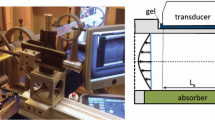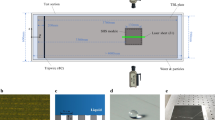Abstract
An experimental study was carried out to investigate the effect of local ultrasonic forcing on a turbulent boundary layer. The ultrasonic forcing system was constructed by adhering six ultrasonic transducers to a flat plate over which water was flowed. In this system, the ultrasonic waves projected into the water by the transducers caused cavitation, giving rise to an enormous number of tiny water-vapor bubbles. Stereoscopic particle image velocimetry (SPIV) was used to probe the flow characteristics. The SPIV results showed that imposition of the ultrasonic forcing caused a substantial increase in the mean wall-normal velocity but a decrease in the mean streamwise velocity. The ultrasonic forcing reduced the skin friction coefficient by up to 60% immediately downstream of the transducers; this effect gradually dissipated with moving downstream. The streamwise turbulence intensity was reduced near the wall but increased away from the wall, whereas the wall-normal turbulence intensity was not much affected near the wall but increased away from the wall. The Reynolds shear stress and the production of turbulent kinetic energy were reduced near the wall. Imposition of the ultrasonic forcing shifted the streamwise vortical structures away from the wall, leading to a reduction in skin friction.















Similar content being viewed by others
Abbreviations
- C f :
-
skin friction coefficient
- K* :
-
energy partition parameter, 2u 2/(v 2+ w 2)
- Re θ :
-
Reynolds number, U ∞θ/ν
- U :
-
mean streamwise velocity
- U ∞ :
-
free-stream velocity (m/s)
- u :
-
streamwise turbulent intensity
- u τ :
-
friction velocity
- −uv :
-
Reynolds shear stress
- V :
-
mean wall-normal velocity
- v :
-
wall-normal turbulent intensity
- w :
-
spanwise turbulent intensity
- x :
-
streamwise direction
- v :
-
wall-normal direction
- z :
-
spanwise direction
- θ:
-
momentum thickness (mm)
- ρ:
-
density (kg/m3)
- υ:
-
kinematic viscosity
- +:
-
normalization by wall unit
- ∞:
-
free-stream
- o:
-
no-forcing
References
Choi H, Moin P, Kim J (1993) Direct numerical simulation of turbulent flow over riblets. J Fluid Mech 255:503–539
Choi H, Moin P, Kim J (1994) Active turbulence control for dra reduction in wall-bounded flows. J Fluid Mech 262:75–110
Delo CJ, Kelso RM, Smits AJ (2004) Three-dimensional structure of a low-Reynolds-number turbulent boundary layer. J Fluid Mech 512:47–83
Ferrante A, Elghobashi S (2004) On the physical mechanisms of drag reduction in a spatially developing turbulent boundary layer laden with microbubbles. J Fluid Mech 503:345–355
Hart DP (2000) PIV error correction. Exp Fluids 29:13–22
Kato H, Iwashina T, Miyanaga M, Yamaguchi H (1999) Effect of microbubbles on the structure of turbulence in a turbulent boundary layer. J Mar Sci Technol 4:155–162
Kim KY, Sung HJ (2003) Effects of periodic blowing from spanwise slot on a turbulent boundary layer. AIAA 41:1916–1924
Kim J, Moin P, Moser R (1987) Turbulence statistics in fully developed channel flow at low Reynolds number. J Fluid Mech 177:133–166
Kodama Y, Kakugawa A, Takahashi T, Kawashma H (2000) Experimental study on microbubbles and their applicability to ships for skin friction reduction. Int J Heat Fluid Flow 21:582–588
Krogstad P, Kourakine A (2000) Some effects of localized injection on the turbulence structure in a boundary layer. Phys Fluids 12:2990–2999
Lee T, Fisher M, Schwarz WH (1993) Investigation of the stable interaction of a passive compliant surface with a turbulent boundary layer. J Fluid Mech 257:373–401
McCormick M, Bhattacharyya R (1973) Drag reduction of a submersible hull by electrolysis. Nav Eng J 85:11–16
Nitche W, Thunker R, Haberland C (1983) A computational preston tube method. In: Proceedings of the fourth symposium on the turbulent shear flows, pp 261–276
Park J, Choi H (1999) Effects of uniform blowing or suction from a spanwise slot on a turbulent boundary layer flow. Phys Fluids 11:3095–3105
Park SH, Lee I, Sung HJ (2001) Effect of local forcing on a turbulent boundary layer. Exp Fluids 31:384–393
Park YS, Park SH, Sung HJ (2003) Measurement of local forcing on a turbulent boundary layer using PIV. Exp Fluids 34:697–707
Rhee GH, Sung HJ (2001) Numerical prediction of locally-forced turbulent boundary layer. Int J Heat Fluid Flow 22:624–632
Robinson SK (1991) Coherent motions in the turbulent boundary layer. Annu Rev Fluid Mech 23:601–639
Sano M, Hirayama N (1985) Turbulent boundary layers with injection and suction through a slit. Bull JSME 28:807–814
Scarano F, Riethmuller ML (1999) Iterative multigrid approach in PIV image processing with discrete window offset. Exp Fluids 26:513–523
Soloff SM, Adrian RJ, Liu ZC (1997) Distortion compensation for generalized stereoscopic particle image velocimetry. Meas Sci Technol 8:1441–1454
Spalart PR (1988) Direct numerical simulation of a turbulent boundary layer up to Re=1410. J Fluid Mech 187:61–98
Westerweel J (1994) Efficient detection of spurious vectors in particle image velocimetry data. Exp Fluids 16:236–247
Xu J, Maxey MR, Karniadakis G (2002) Numerical simulation of turbulent drag reduction using micro-bubbles. J Fluid Mech 468:271–281
Author information
Authors and Affiliations
Corresponding author
Rights and permissions
About this article
Cite this article
Park, Y.S., Sung, H.J. Influence of local ultrasonic forcing on a turbulent boundary layer. Exp Fluids 39, 966–976 (2005). https://doi.org/10.1007/s00348-005-0021-9
Received:
Revised:
Accepted:
Published:
Issue Date:
DOI: https://doi.org/10.1007/s00348-005-0021-9




